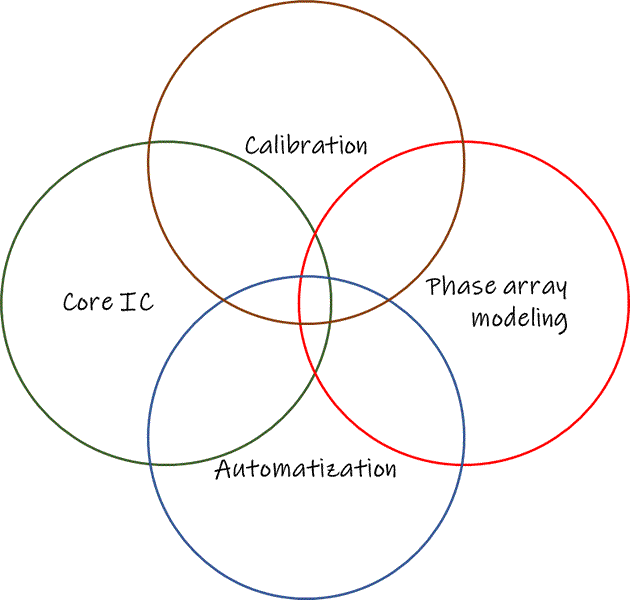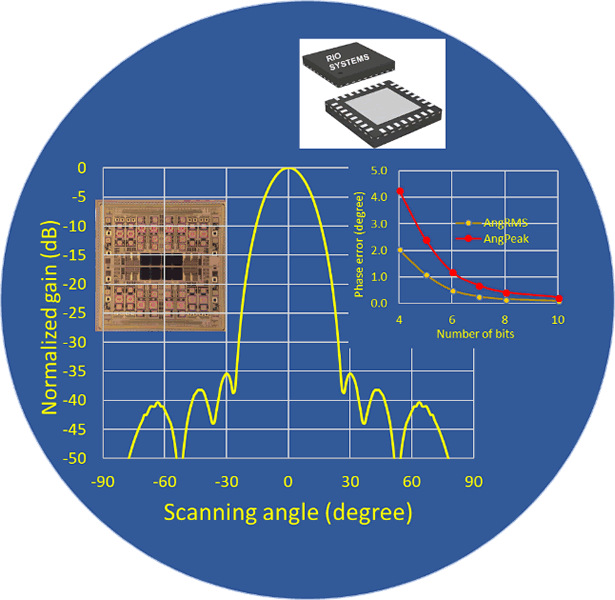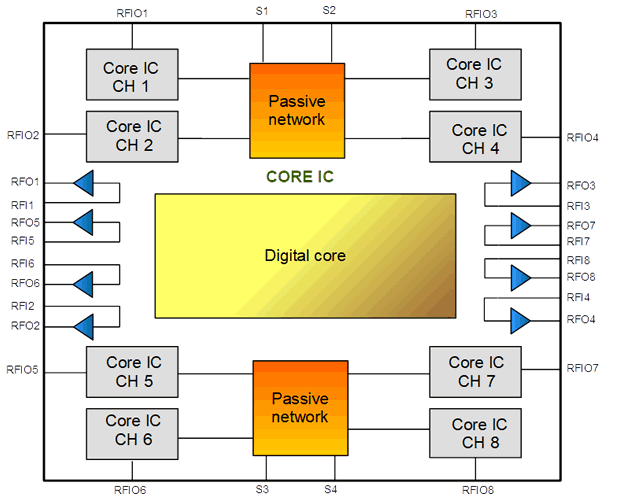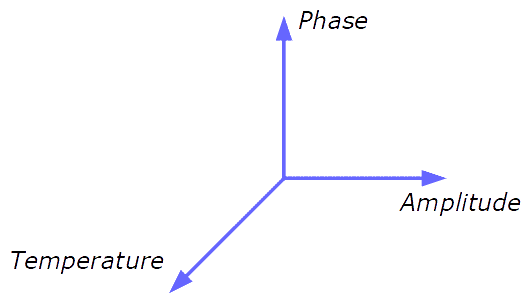Core ICs
Rio Systems offers a full-set of technologies for 5G communication and aerospace & defense phase array applications as illustrated herein. It comprises the core ICs, modeling, calibration, and automatization. The careful design of the complete solution enables its customers to meet the stringent system requirements for simultaneous multi-user operation, high antenna gain, and interference mitigation.


Rio Systems provides a multi-channel core IC to support phase arrays applications for aerospace & defense, 5G and satellite communications at different frequency bands. User defined specifications and configuration for the core IC are available upon request.
| Product name | Frequency range (GHz) | Mode | Channels |
| RS7308L | 0.8 – 3.5 | TX/RX | 4 |
| RS7308C | 3 – 6.2 | TX/RX | 4 |
| RS7308X | 8 – 11 | TX/RX | 4 |
| RS7308XT | 8 – 11 | TX | 8 |
| RS7308K | 10.7 – 15 | TX/RX | 4 |
| RS7308KU | 15 – 17.5 | TX/RX | 4 |
The multi-channel core IC comprises 8 core IC units which can be arranged as transmitter, receiver and TX/RX units according to the application. The core IC platform offers 8 standalone low noise amplifiers to further improve the link capacity and reduce the cost of additional amplifiers.
Each identical core IC channel can be arranged as transmitter, receiver and TX/RX units to support different system configurations.
Customization
The core ICs can be customized to any frequency within the process technology limitations to support specific custom applications at different frequency bands
- Number of channels: 4 or 8
- RMS phase accuracy < 1 degree
- Noise figure < 10 dB
- 8-bit phase and amplitude controls
- Independent phase and amplitude calibrations
- Integrated LUT
- SPI configuration
- 8 V / 3.3 V supply
- 6-watt power consumption
- QFN 64 package

- Radar phase arrays
- 5G communication
- Antenna beam forming
- Interference cancellation
Deliverables for phase arrays
- Core ICs
- EVB and control software
- Modeling solutions
- Measurement automatization
- Calibration
Modeling the amplitude to phase conversion and the phase to amplitude conversion in active core ICs is fundamental to meet the sid lobe levels when array functions as Dolph–Tschebyscheff arrays are used. Without an adequate model, the practical realization of arrays becomes cumbersome.
Rio Systems provide a set o modeling tools to support the integration of core ICs into actual systems. The modeling solutions are offered in Keysight Technologies EDA tools as ADS and System Vue. This list of modeling solutions is outlined in the Table below
| Part number | Description | EDA tool | Results |
| RS7308MDL | Behavioral model of the core IC implemented in the System Vue environment. The model includes the main impairments at the core IC that influences on the phase accuracy and RF system performance | System Vue | Quantify the source of errors and its effect on the system and phase accuracy |
| RS7308LIN8A | Behavioral model describing the array with 8 elements using the core IC behavioral model. Phase accuracy and RF system impairments are taking into account | System Vue | Predict the 8-element array performance at different scanning angles |
| RS7308LIN10A | Behavioral model describing the array with 8 elements using the core IC behavioral model. Phase accuracy and RF system impairments are taking into account | System Vue | Predict the 10-element array performance at different scanning angles |
| RS7308LIN16A | Behavioral model describing the array with 10 elements using the core IC behavioral model. Phase accuracy and RF system impairments are taking into account | System Vue | Predict the 16-element array performance at different scanning angles |
| RS7308EM | Parametrized physical model for NxM patch antenna elements. Each element is driven by an individual phase shifter and amplitude control units. | ADS | Coupling matrix between elements
Array performance at different scanning angle |
Calibration provides control over the beam width and nulls for interference mitigation to improve the link budget for different scanning angles. Impairments at the IC, board and antenna levels result in non-ideal excitation at the individual array elements. Such deviation from the predicted excitation results in a different beam forming characteristic than initially projected which compromises the link budget and the ability to cope with interference signals. Calibration is therefore required to compensate for these impairments.
Rio Systems offers a comprehensive calibration approach for its core ICs to compensate for the accuracy errors. The derived correction vector applied to the core IC cancels out the influence of impairments present at the core IC and board levels on phase arrays.

| Coverage range | Increment | Number of points | |
| Phase | 360 degrees | 1 degree | 360 |
| Amplitude | 30 dB | 0.5 dB | 60 |
| Temperature | -40 C to 85 C | -40/25/70/85 C | 4 |
| Total number of data | 86400 | ||
Rio Systems offers a comprehensive automatization solution based on Python language for automatization of the core IC measurements.
